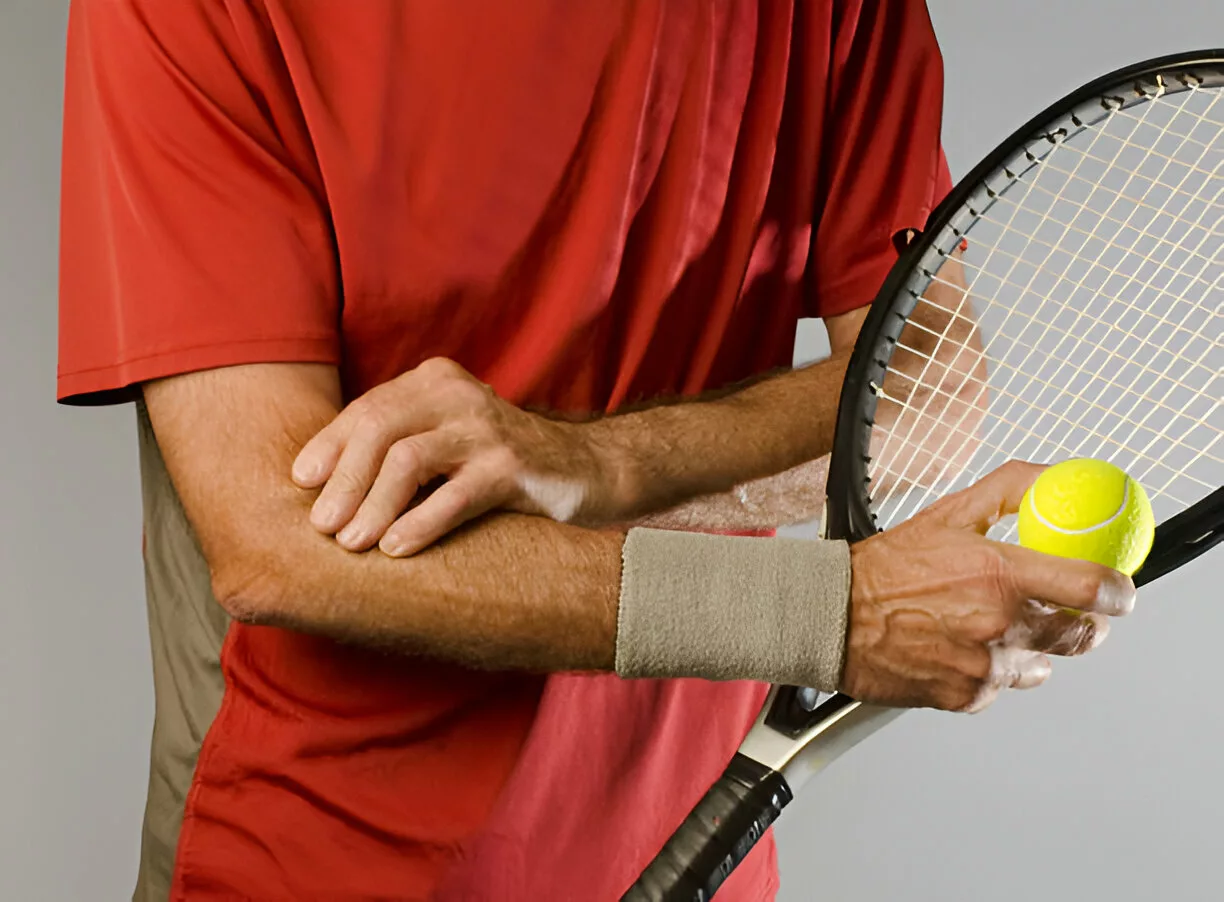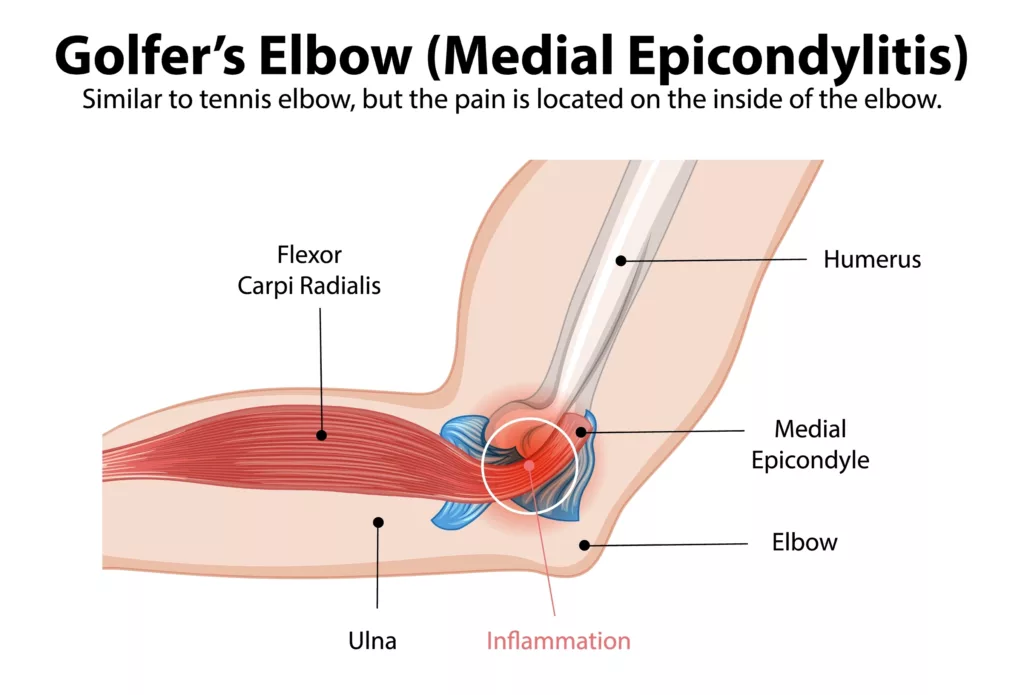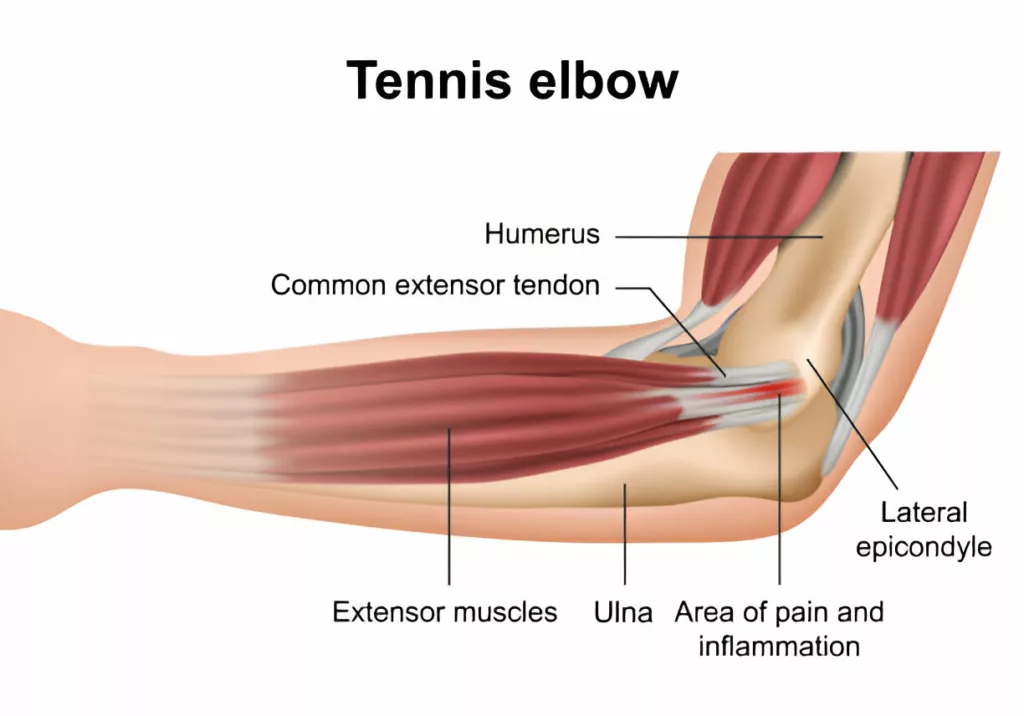Medial epicondylitis, also referred to as medial elbow tendinopathy (MET), is a type of overuse tendinopathy that affects the tendons attaching to the medial epicondyle of the humerus—the bony bump on the inner side of your elbow. This site is the origin of the wrist flexor muscles. Repetitive activities involving gripping, wrist flexion, or forearm rotation can lead to tiny tears in these tendons, resulting in pain at the inner elbow, which may radiate to the wrist or forearm.1Werner RA, Franzblau A, Gell N. “Prevalence of upper extremity musculoskeletal disorders in automobile manufacturing: A pilot study including questionnaires and physical examinations.” Journal of Occupational Rehabilitation. 2005;15(3):331-45. DOI: 10.1007/s10926-005-1211-9.
Although it’s called Golfer’s elbow, most people diagnosed with MET are not athletes. In fact, repetitive occupational activities are often the cause. Untreated MET can become chronic, reducing elbow function and grip strength.

Are You at Risk?
Epidemiological data suggest that medial epicondylitis affects about 0.4% of the general population, with a higher incidence among people aged 45 to 54. Known risk factors include:2Shiri R, Viikari-Juntura E, Varonen H, Heliövaara M. Prevalence and determinants of lateral and medial epicondylitis: a population study. Am J Epidemiol. 2006 Dec 1;164(11):1065-74. doi: 10.1093/aje/kwj325. Epub 2006 Sep 12. PMID: 16968862.
- Age between 45 to 64 years
- Female gender (slightly higher prevalence)
- Jobs or activities that involve repetitive hand, wrist, or arm motions (e.g., carpenters, plumbers, painters, butchers, cooks, and office workers who use computers extensively)
- Improper technique during sports or exercise
- Neck pain or nerve root issues
- Handling heavy loads (≥20 kg)
- Weak shoulder or wrist muscles
Symptoms of Golfer’s Elbow
Golfer’s elbow, or medial epicondylitis, often develops gradually and may take weeks or even months before symptoms become noticeable. The condition causes pain and tenderness on the inside of the elbow, especially where the forearm tendons attach to the medial epicondyle. This discomfort is typically worse in the morning or after repetitive wrist and forearm activity. Some people may also experience stiffness, weakness in the wrist or grip, or tingling sensations that can radiate into the fingers, particularly the ring and little fingers.
Common symptoms include:3American Academy of Orthopaedic Surgeons. (n.d.). Medial epicondylitis (Golfer’s Elbow). OrthoInfo. Retrieved April 23, 2025, from https://orthoinfo.aaos.org
- Inner elbow pain, worsened by wrist flexion or forearm pronation
- Pain when making a fist or gripping objects
- Weakness in the hand or forearm
- Stiffness or reduced grip strength
- Tingling or burning in the forearm or hand
- Discomfort when swinging, throwing, or lifting
- Possible mild swelling around the elbow
If left untreated, symptoms can become persistent, limiting daily activities and athletic performance.
Difference between Medial & Lateral Epicondylitis
Epicondylitis refers to inflammation or degeneration of the tendons that attach to the epicondyles—bony projections on either side of the lower humerus at the elbow joint.4UpToDate. (2024). Medial elbow tendinopathy (Golfer’s elbow). In G. S. O’Connor (Ed.), UpToDate. Wolters Kluwer. Retrieved April 23, 2025, from https://www.uptodate.com
Medial Epicondylitis (Golfer’s Elbow):
Affects the inner (medial) side of the elbow. It involves tendons that control wrist flexion and forearm pronation, particularly the flexor carpi radialis and pronator teres. Common in golfers, throwers, and individuals with repetitive wrist/finger flexion.

Lateral Epicondylitis (Tennis Elbow):
Affects the outer (lateral) side of the elbow. It involves tendons responsible for wrist extension, especially the extensor carpi radialis brevis (ECRB). Common in tennis players and those doing repetitive wrist extension or gripping.
Both conditions are caused by overuse and lead to tendon degeneration rather than acute inflammation in most chronic cases.

Diagnosis of Medial Epicondylitis
The diagnosis of medial epicondylitis (Golfer’s Elbow) is primarily clinical, based on the patient’s history and physical examination. Common symptoms include localized pain and tenderness over the medial epicondyle and proximal flexor muscle mass. The following tests are frequently used to confirm the diagnosis:
Polks Test:
Polk’s test helps differentiate between medial and lateral epicondylitis. It works by placing the wrist flexors and extensors under tension when the hand grips an object. Lifting an object increases the strain on the affected muscle group, which can trigger pain at the musculotendinous attachment, helping to identify medial epicondylitis.
Golfers’ Elbow Test:
The Golfer’s Elbow Test specifically tests for medial epicondylitis. In this test, the patient sits or stands while the clinician palpates the medial epicondyle. The clinician then passively supinates the forearm, fully extends the elbow, wrist, and fingers. A positive result is marked by abrupt pain or discomfort along the medial epicondylar region, indicating medial epicondylitis.5Zafar, H., et al. “Golfer’s elbow test: A clinical diagnostic test for medial epicondylitis.” Journal of Shoulder and Elbow Surgery 24.6 (2015): 965-970.
Additional tests, such as resisted wrist flexion, passive wrist extension, and modified book tests, can also be performed to confirm the diagnosis and evaluate the extent of tendinopathy.
Imaging is typically not required for most patients with classic clinical signs. However, musculoskeletal ultrasound (MSK US) can be helpful in assessing tendon thickness, detecting partial tears, calcifications, and neovascularity. For patients with severe or persistent symptoms, plain radiographs or MRI may be indicated to rule out other pathologies, such as fractures or osteoarthritis.6Chen AL, Youm T, Ong BC, Rafii M, Rokito AS. Imaging of the elbow in the overhead throwing athlete. Am J Sports Med. 2003 May-Jun;31(3):466-73. doi: 10.1177/03635465030310032601. PMID: 12750146.
Treatment options for Medial Epicondylitis
Golfer’s elbow is typically managed with conservative treatments that help alleviate pain, reduce inflammation, and promote healing. Common approaches include:7Agha, R. A., et al. “Management of lateral and medial epicondylitis of the elbow.” Journal of Orthopaedic Surgery and Research 6.1 (2011): 42.
Conservative Management:
Rest & Activity Modification
Rest and avoid putting more strain on your elbow and forearm.
Physical Therapy
A tailored physical therapy program is often the cornerstone of conservative treatment. This includes:
- Stretching and Strengthening Exercises: Focus on the wrist flexors, forearm muscles, and tendons to promote flexibility and strength.
- Pain Management: Techniques such as moist heat, ice, or ice massage can help reduce pain and inflammation.
- Iontophoresis: The application of anti-inflammatory medication using an electrically charged patch to reduce pain.
- Manual Therapy: Includes gentle joint mobilizations, soft tissue massage, and targeted stretches for the wrist, forearm, and elbow. Exercises for the shoulder and thoracic spine are also included to address muscular imbalances along the kinetic chain.
- Bracing or Splinting: Wearing an elbow brace can help support the affected area and reduce strain on the tendons.
Ice & Cold Therapy
Applying ice to the injured area helps reduce swelling and alleviate pain.
Kinesiology Tape (K-Tape)
K-Tape can be used to relieve pain and support the muscles around the elbow and wrist. The tape is applied with a 25-50% stretch to help reduce tension on the affected tendon. It can be worn for up to 5 days, depending on patient tolerance.
Medications:
Several medications are used to reduce the pain due to tendon inflammation. These medications include:
- Over-the-counter pain relievers (NSAIDS, Paracetamol, etc.)
- Anti-inflammatory drugs to reduce swelling and discomfort.
- Corticosteroid injections are also an option, but they do not provide long-term pain relief.
- PRP (Plasma rich platelet) is a newer trial in research.8Monto, R. R., & Gupta, A. (2020). Platelet-rich plasma for the treatment of medial epicondylitis: A systematic review and meta-analysis. PM&R, 12(5), 451-459. https://doi.org/10.1002/pmrj.12243
Surgical Management:
Medial Epicondyle Release
This procedure involves cutting the affected tendon at the medial epicondyle to relieve tension and allow for healing. A portion of the damaged tendon may be removed.
Arthroscopic Debridement:
Minimally invasive surgery using a small camera to remove degenerative tissue or debris from the tendon.
Last but not Least
Although medial epicondylitis is a painful inflammation of the forearm to elbow, but manageable. Thus, if one is entering their forties, one should be careful in their movements. A brisk or slightly abrupt movement of the upper limbs can cause medial epicondylitis and make you uncomfortable for a few days. Just take care of your age and its limitations.
Refrences
- 1Werner RA, Franzblau A, Gell N. “Prevalence of upper extremity musculoskeletal disorders in automobile manufacturing: A pilot study including questionnaires and physical examinations.” Journal of Occupational Rehabilitation. 2005;15(3):331-45. DOI: 10.1007/s10926-005-1211-9.
- 2Shiri R, Viikari-Juntura E, Varonen H, Heliövaara M. Prevalence and determinants of lateral and medial epicondylitis: a population study. Am J Epidemiol. 2006 Dec 1;164(11):1065-74. doi: 10.1093/aje/kwj325. Epub 2006 Sep 12. PMID: 16968862.
- 3American Academy of Orthopaedic Surgeons. (n.d.). Medial epicondylitis (Golfer’s Elbow). OrthoInfo. Retrieved April 23, 2025, from https://orthoinfo.aaos.org
- 4UpToDate. (2024). Medial elbow tendinopathy (Golfer’s elbow). In G. S. O’Connor (Ed.), UpToDate. Wolters Kluwer. Retrieved April 23, 2025, from https://www.uptodate.com
- 5Zafar, H., et al. “Golfer’s elbow test: A clinical diagnostic test for medial epicondylitis.” Journal of Shoulder and Elbow Surgery 24.6 (2015): 965-970.
- 6Chen AL, Youm T, Ong BC, Rafii M, Rokito AS. Imaging of the elbow in the overhead throwing athlete. Am J Sports Med. 2003 May-Jun;31(3):466-73. doi: 10.1177/03635465030310032601. PMID: 12750146.
- 7Agha, R. A., et al. “Management of lateral and medial epicondylitis of the elbow.” Journal of Orthopaedic Surgery and Research 6.1 (2011): 42.
- 8Monto, R. R., & Gupta, A. (2020). Platelet-rich plasma for the treatment of medial epicondylitis: A systematic review and meta-analysis. PM&R, 12(5), 451-459. https://doi.org/10.1002/pmrj.12243

